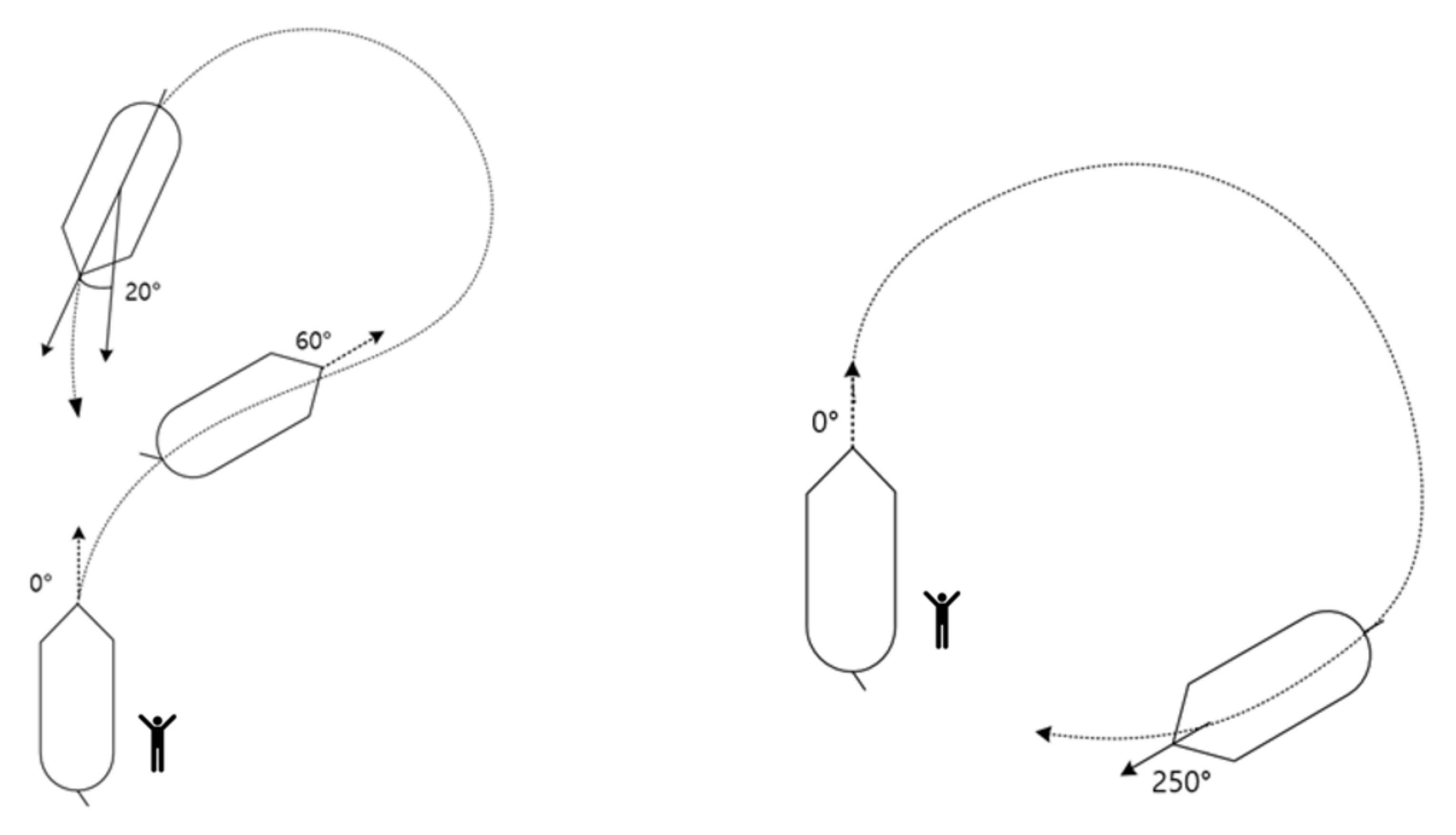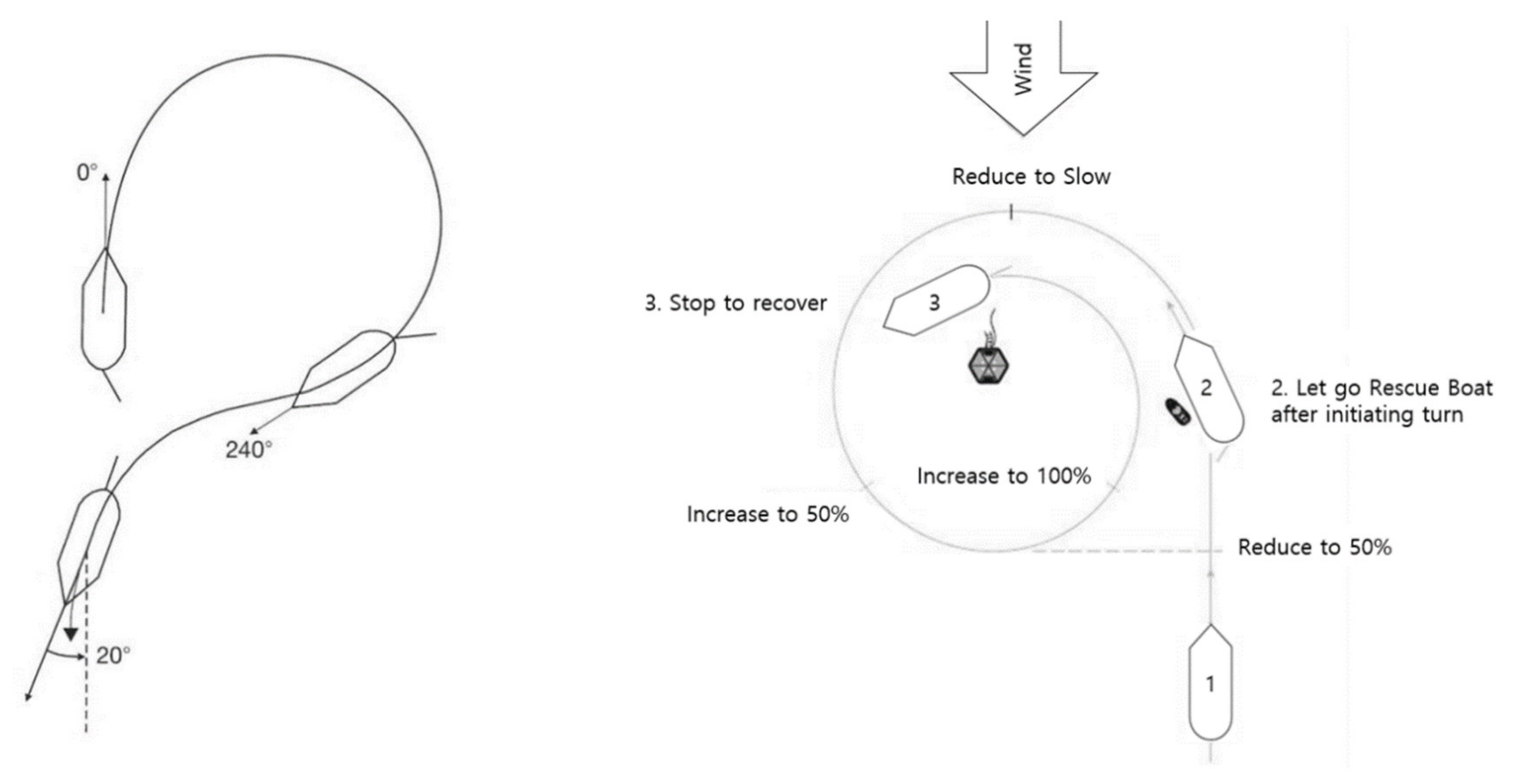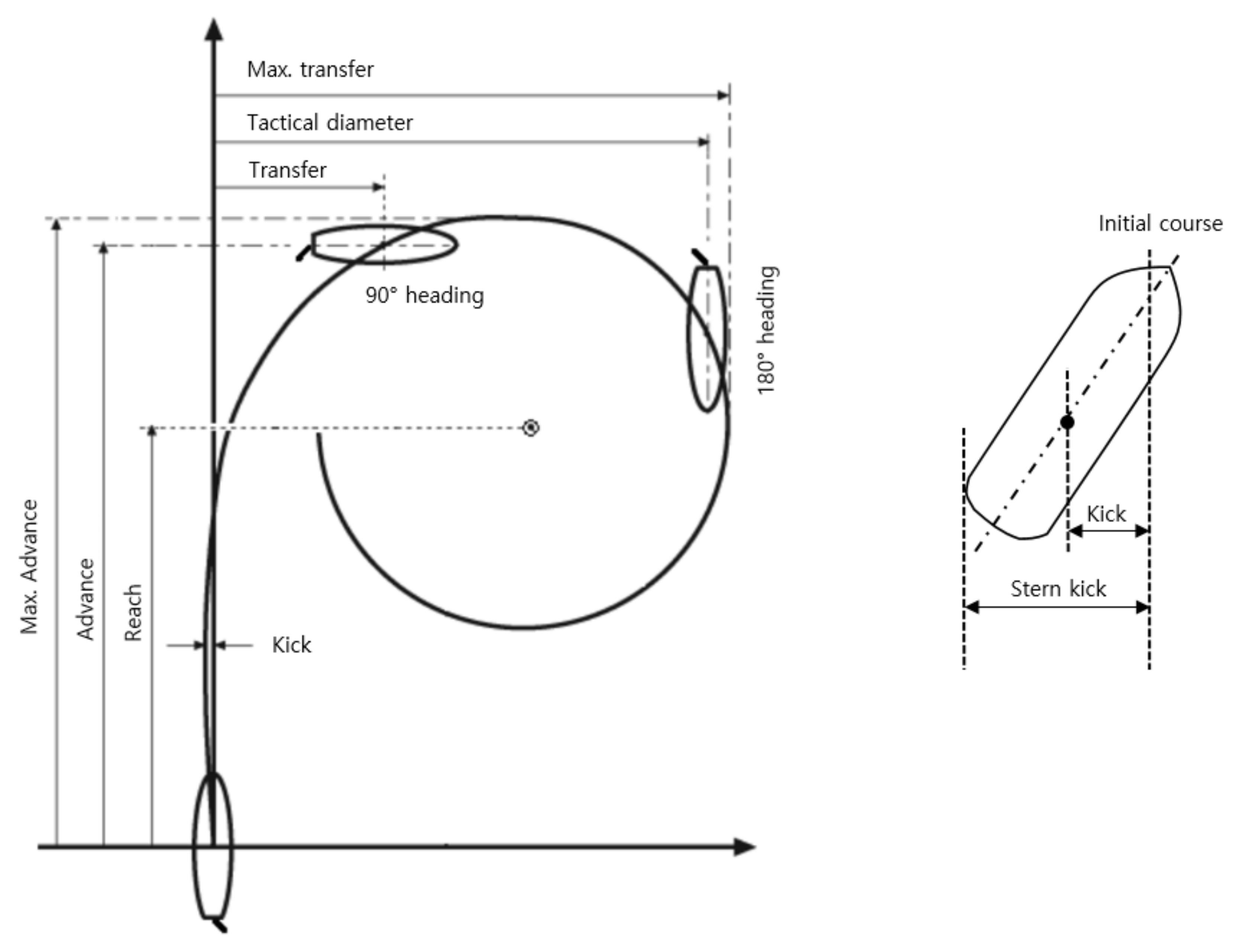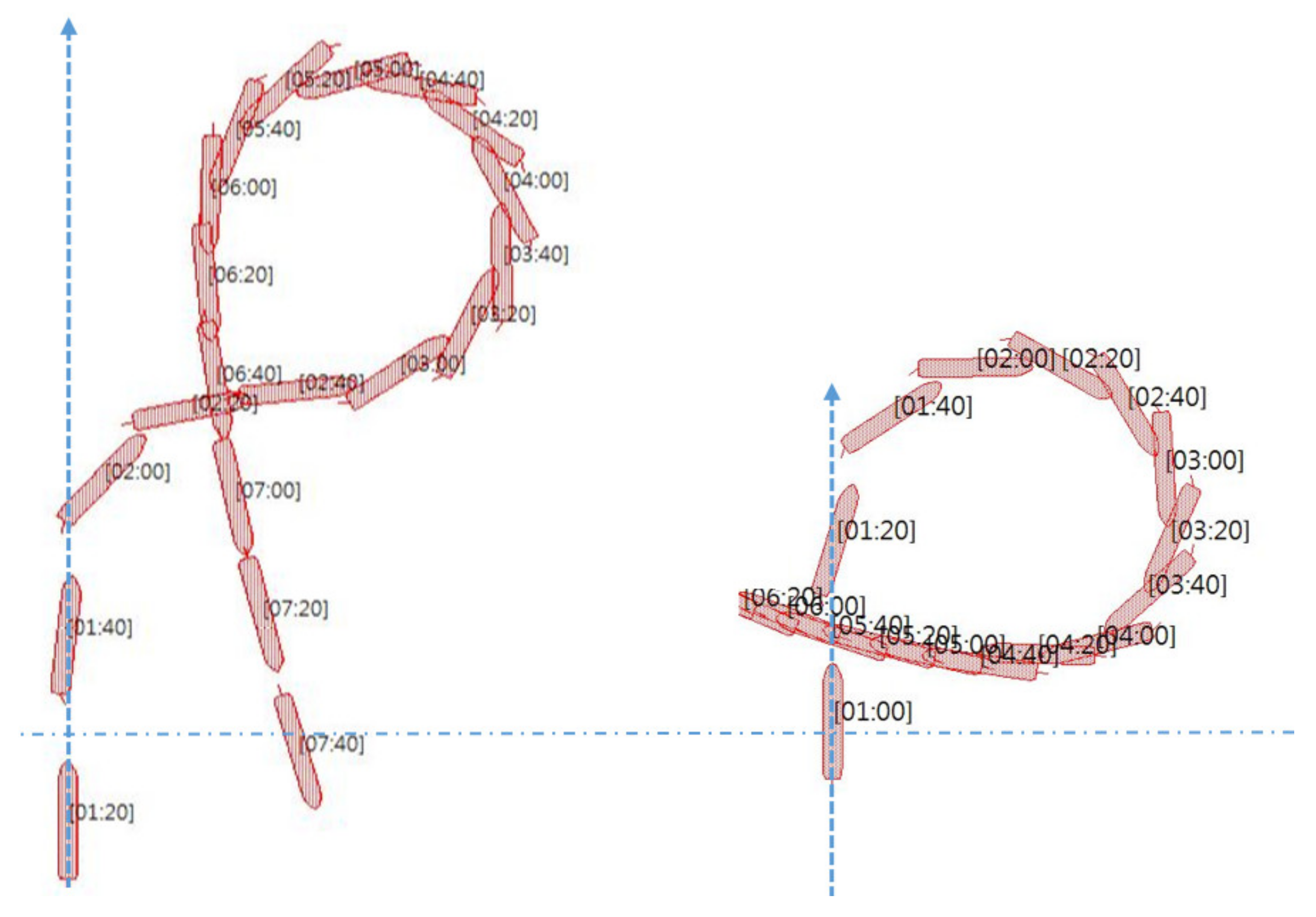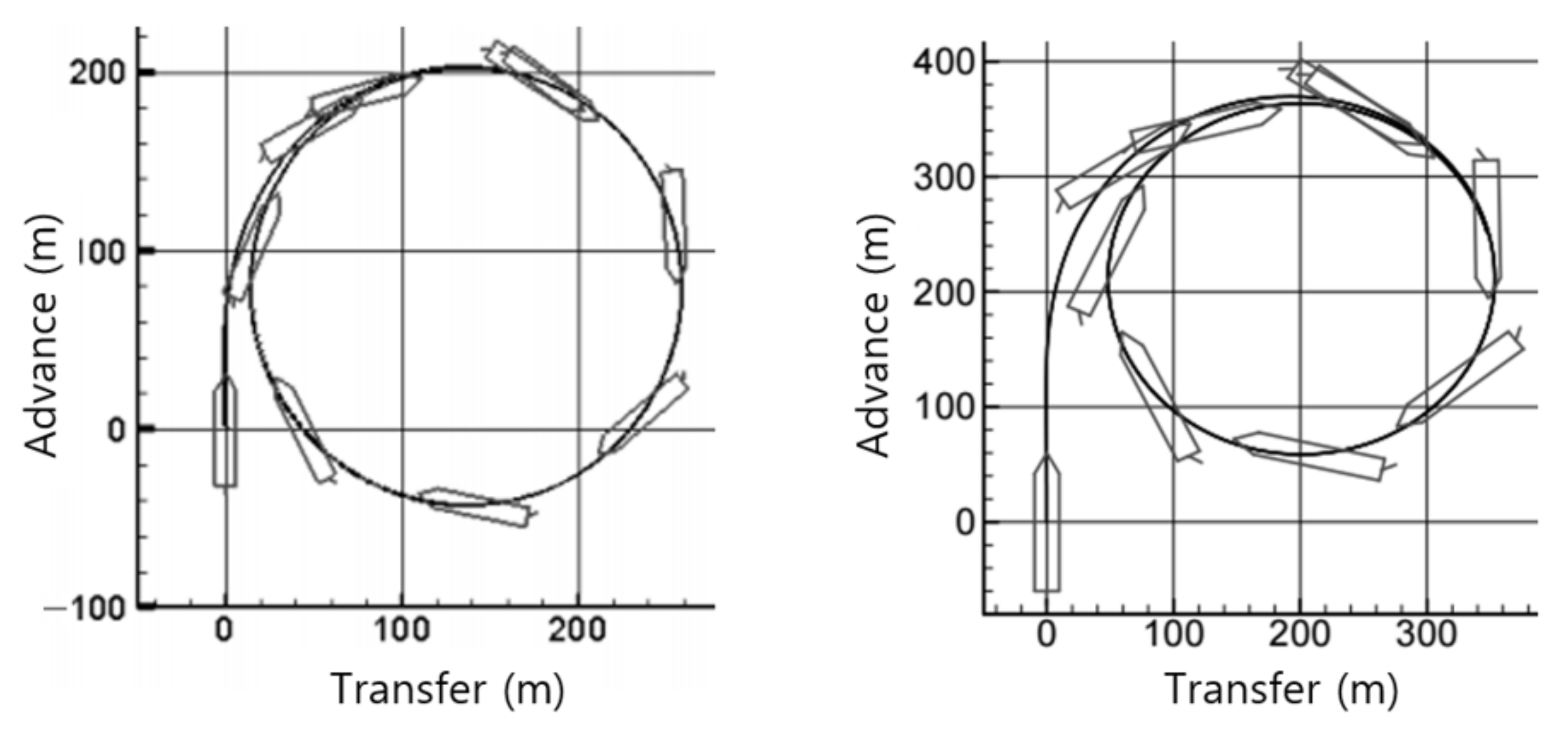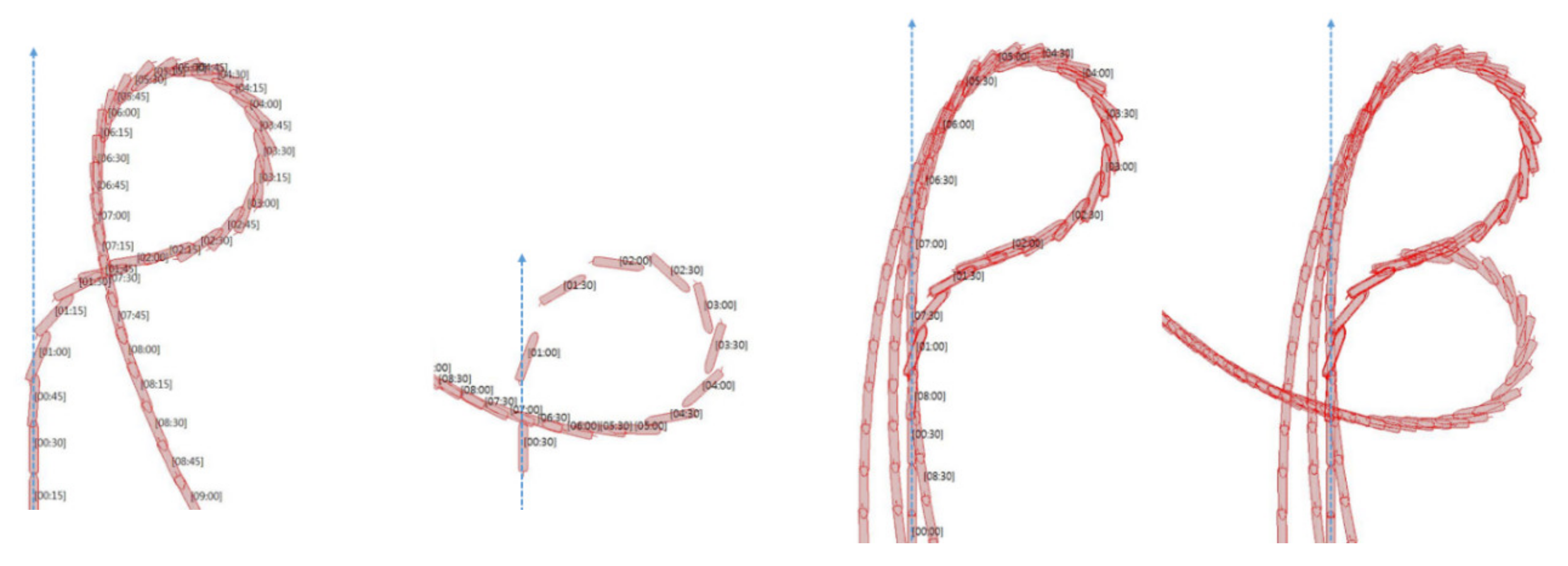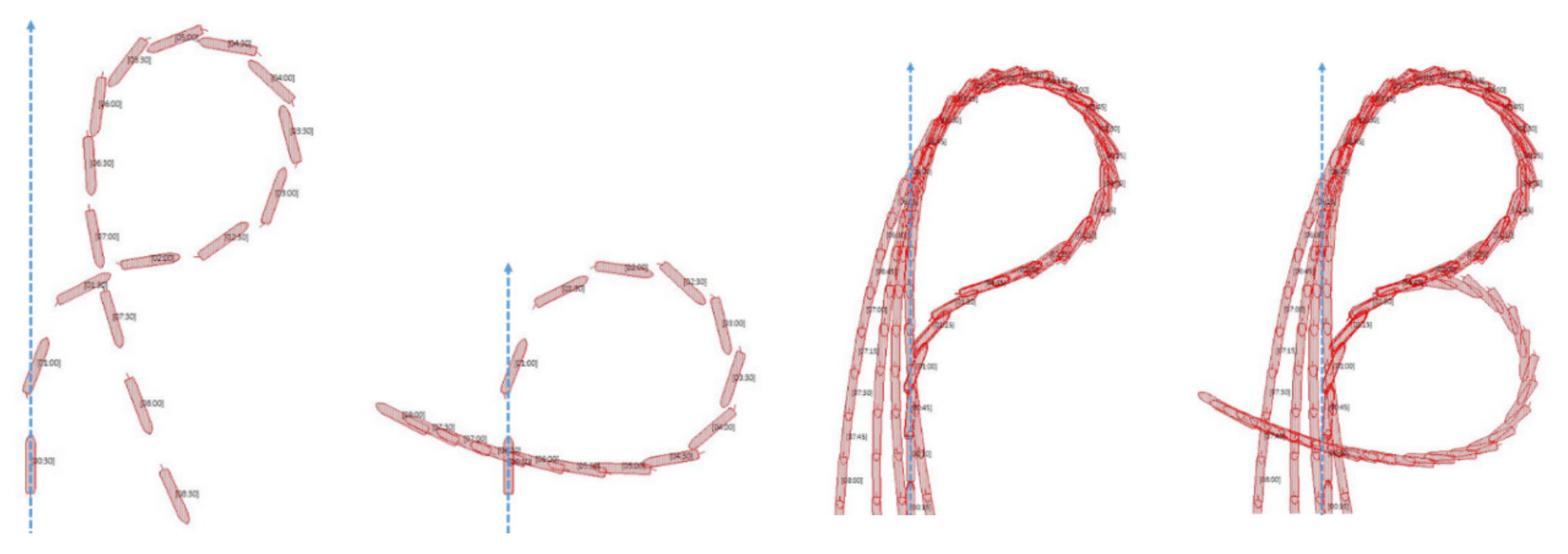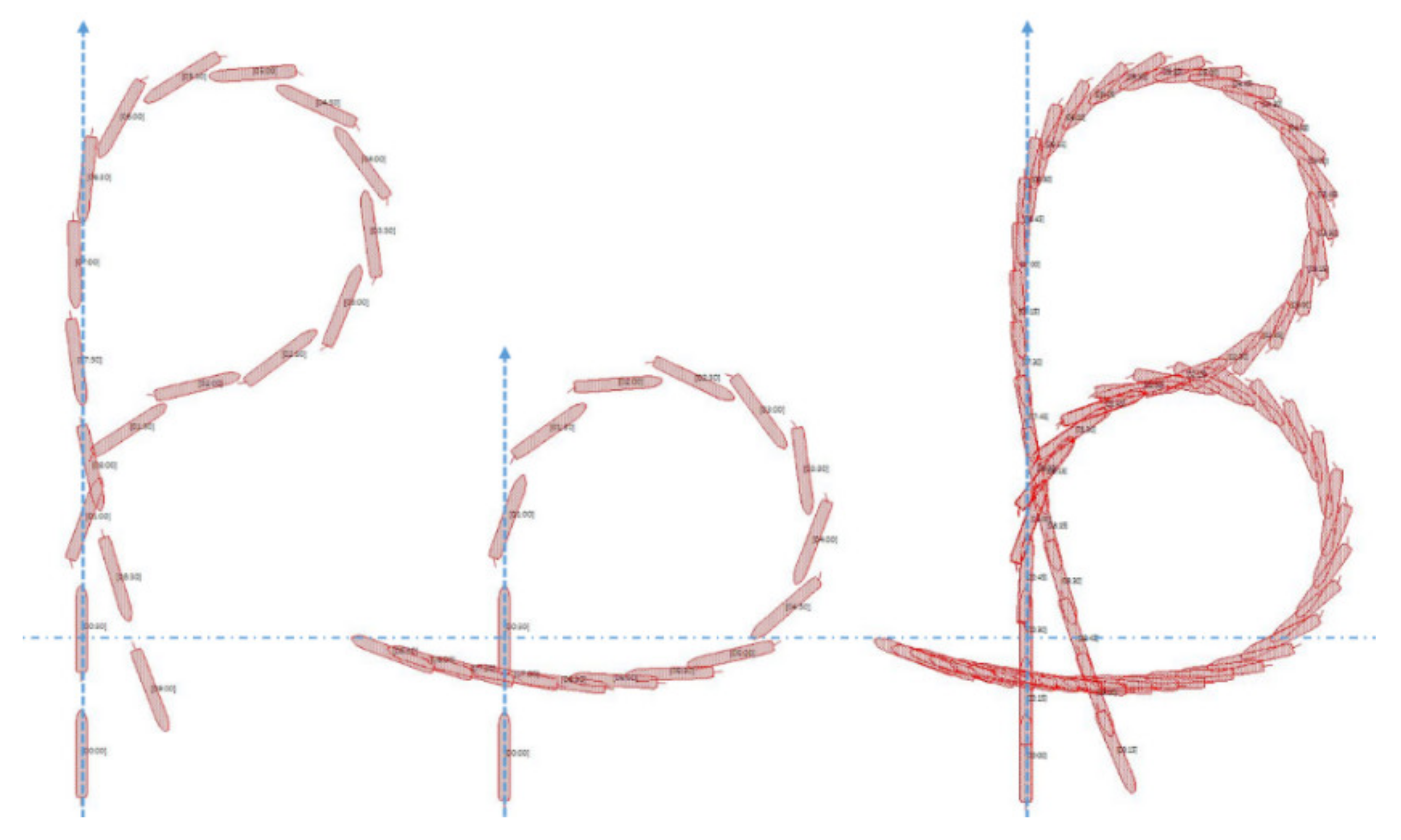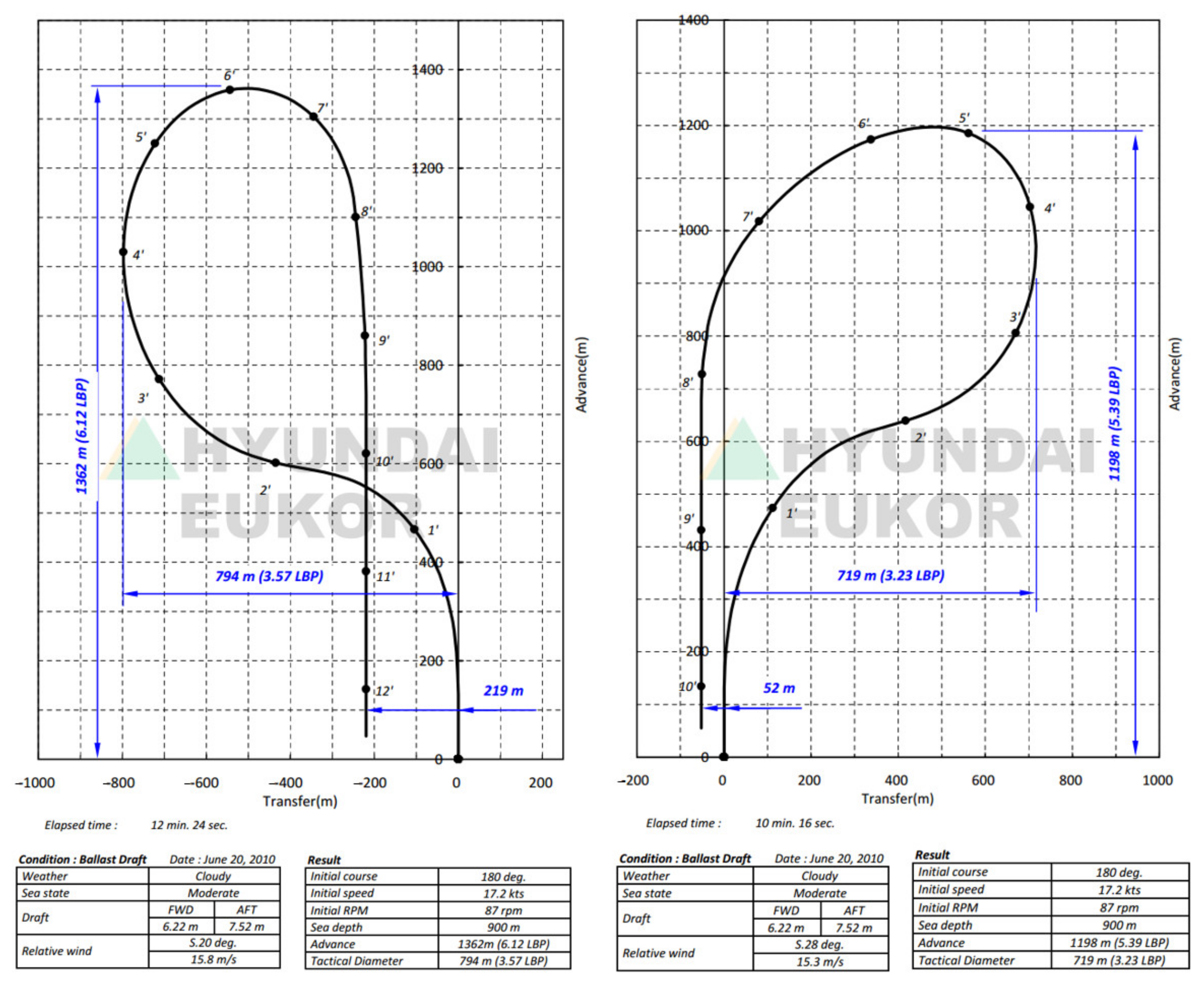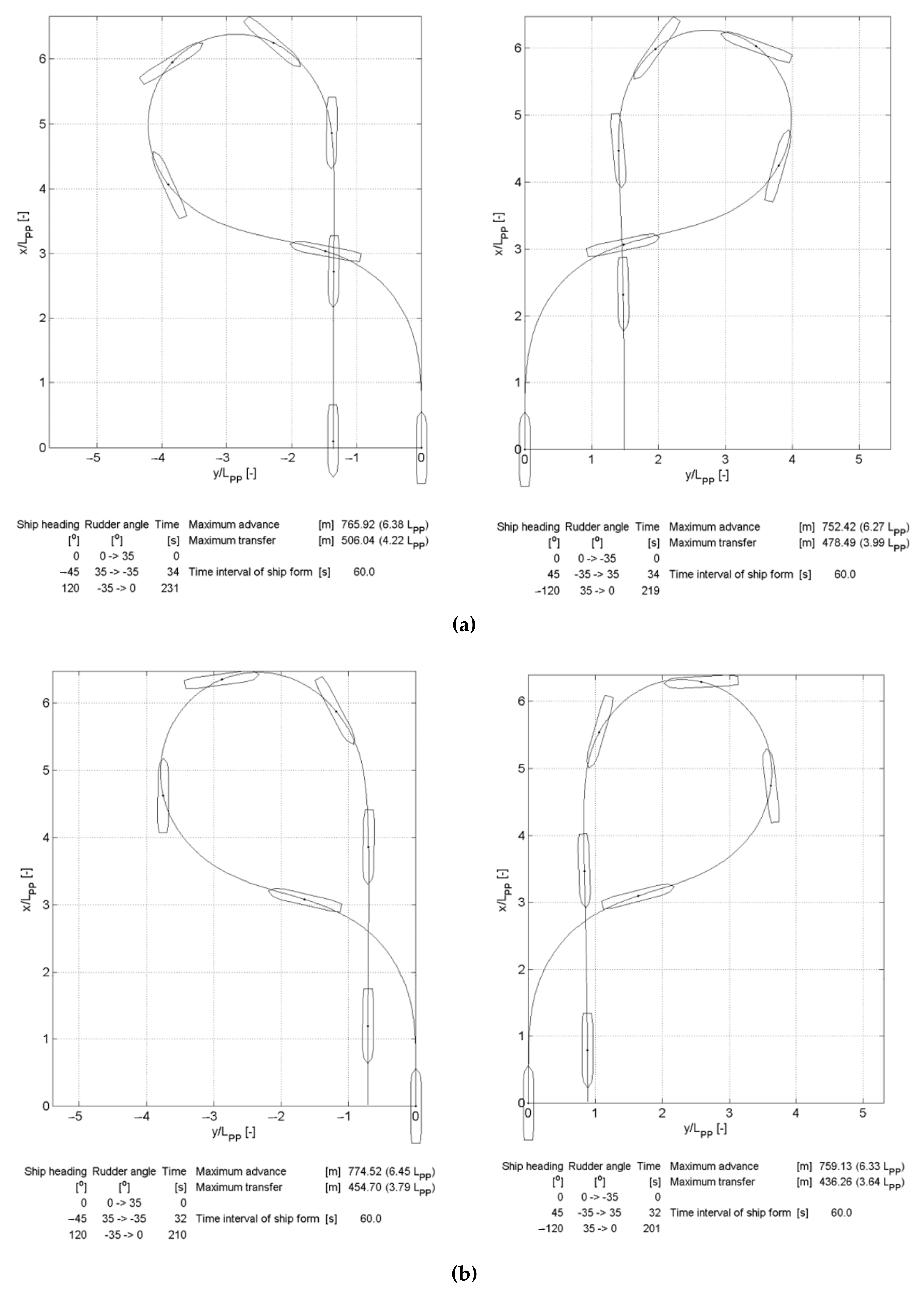1. Introduction
The International Aeronautical and Maritime Search and Rescue (IAMSAR) Manual is regarded as a set of internationally recognized practical rules for emergency preparedness at sea. With ICAO’s concurrence, the IMO revises the IAMSAR Manual every three years.
The IAMSAR Manual is composed of three volumes. The first volume covers Search and Rescue (SAR) organization and management for IMO member states, and the second volume is for mission co-ordination among neighboring states. The 1979 SAR Convention, on which the two volumes are based, dealt with the development of an international SAR plan which ensures that, no matter where a marine or aeronautical accident occurs, the rescue of persons in distress will be co-ordinated by a SAR organization and, when necessary, by co-operation among neighboring SAR organizations [
1].
Volume III is aimed at rendering assistance to mobile facilities with respect to search and rescue. It is one of the requisite publications for merchant ships engaged in international voyages [
2]. In terms of emergency preparedness, the IAMSAR manual III is generally recognized as a contingency field manual, and is one of the most practical publications for seafarers when they are in distress or obliged to help others in distress [
3]. In any given problematic circumstances, the field manual can be trusted. The readers should translate the field manual adequately in emergencies where they are pushed to follow the manual. These situations can be error-provoking, as novices and experts are equally unproficient at solving new and novel problems, indicating that ordinary people are likely to be incapable of taking excellent action in unfamiliar and unwanted situations, such as man-overboard [
4]. We also acknowledge that humans are essentially error-making and error-correcting entities [
5]; nevertheless, appropriate field manuals can help non-professionals to clarify themselves in unfamiliar situations.
In this regard, the IAMSAR Manual III is required to be carefully written, as well as to disclose its limitations in order to avoid human error, which is known to be a major cause of transportation accidents [
6,
7,
8,
9]. According to the extensive study of Hale and Glendon, it is generally accepted that 80–90% of accidents are caused by human factors [
5]. The Korea Coast Guard announced that about 85% of maritime accidents had human factors as their primary cause in 2005 and 2006 [
10]. Recent statistics of the Korean Maritime Safety Tribunal indicate that about 90% of maritime accidents from 2015 to 2019 were caused by human factors, as shown in
Table 1 [
11].
As shown in
Table 2, one of the causal factors of human error is unsafe procedures or manuals, according to the SHEL model, a human error identification tool [
12].
The SHEL model has been used in not only the maritime industry, but also the aeronautical industry [
12,
13]. It was recommended by the IMO as a tool for exploring the interaction of every part of the maritime transportation system in a marine accident. The SHEL model is an interviewing and organizational tool used by marine accident investigators for the collection of information necessary to fill in the timeline regarding the human aspects of a marine accident. All of the operational elements of the maritime transportation system can belong to any of the four categories of the model: software, hardware, environment and liveware [
4,
12].
Well-intentioned manuals or rules could be misused due to unclear instructions, leading to human error, such that decent rules should have two parts; (1) matching the situation and (2) providing a line of action to solve the problem [
4].
There are currently four standard recovery maneuvers for man-overboard: the Williamson turn, the Anderson turn, the Scharnov turn and the Lorén turn. Newly adopted in 2019, the Lorén turn is believed to be the imperative practice under time limitations. However, several studies have pointed out that the results of the Williamson turn did not match up with the expected tracks. The Williamson turn starts with the rudder hard over (maximum rate turn to one side), and then moves the rudder hard over to the opposite side at a 60° yaw angle from the original course [
2]. Handysize ships with an average L/B ratio of 7–8 showed the expected results, but Panamax ships (whose L/B is about six or less) did not approach to initial tracks after a 180° turn; instead, they headed to the initial track when the yaw angle was 35–45° [
14]. According to the simulation results of six ships with lengths from 50 m to 322 m, the yaw angles of the Williamson turn were not large enough for ships to come back to their original tracks [
15]. Another simulation study was carried out to find the correct figures of yaw angles for a coast guard ship with length 112.7m, breadth 14.2m, max speed 18 knots and displacement 2946.4 tons. The ship successfully turned to the opposite course when the rudder was hard over to the opposite side after deviation from the original course by 70°, and to a midship position at a heading 15° short of the opposite course [
16]. In the case of Very Large Carriers (VLCs), the Williamson turn can hardly be applied, due to the great inertia and dynamic instability of VLCs [
17].
The above-mentioned research indicates the need for modification of the instructions for the Williamson turn. However, the IMO has maintained the instructions of the Williamson turn. Thus, this paper is motivated by a doubt as to whether the standard recovery maneuvers can be applied to all types of ships. We intended to provide any formula which helps to modify the yaw angles of the Williamson turn or alternatives, such as guidance or remarks on the limitation of the turn. Hence, a series of ship-handling simulations were carried out to review the utility of the Williamson turn and the other standard recovery maneuvers in the IAMSAR Manual III, because it is reasonable to deem that the other turns also need verification, considering that the Williamson turn is in doubt.
Therefore, this paper is aimed at reviewing the serviceability of standard recovery turns, and proposes how to improve the serviceability of the turns, from the viewpoint of users, for the prevention of human error in error-prone applications of rules.
2. The Standard Recovery Maneuvers and Review Targets
2.1. Recent Development of Standard Recovery Maneuvers
The Maritime Safety Committee (MSC) of IMO was invited by Navigation, Communications, Search and Rescue (NCSR), one of its sub-committees, to approve the draft MSC circular on amendments to the IAMSAR Manual [
18]. The MSC approved MSC.1/Circ.1594 on amendments to the IAMSAR Manual, with ICAO’s agreement on the inclusion of the amendments in the 2019 edition of the Manual [
19]. The wording of each standard maneuver was the same as in the previous version of the Manual, except for the Lorén turn.
2.2. Williamson Turn and Anderson Turn
The Williamson turn and the Anderson turn are to be carried out in an ‘immediate action’ situation. As shown in
Figure 1, the first step of these turns is the rudder hard over to the side of the casualty. This is intended for using a kick effect, which initiates the turning of the ship’s stern to the opposite side of the rudder hard over.
Under the IAMSAR manual III the Williamson turn is a simple maneuver leading to a good original track line, showing fair performance in reduced visibility and when the ship is taken farther away from the scene of the incident; however, its procedure is slow and time-consuming. The Anderson turn is the fastest recovery method, which is suitable for ships with tight turning characteristics, and is used most by ships with considerable power; however, it is tough to perform for a single-screw vessel and is challenging, as the approach to the site of the casualty is not straight.
2.3. Scharnov Turn and Lorén Turn
Although these turns are for emergencies, the Shrarnov turn and the Lorén turn, as shown in
Figure 2, are not for an ‘immediate action’ situation. According to the IAMSAR manual III, the Scharnov turn takes the vessel back into her wake to save time, as less distance is covered; however, it cannot be carried out effectively unless the time elapsed between the occurrence of the incident and the commencement of the maneuver is known. The primary purpose of the Lorén turn is to facilitate the launch and recovery of a rescue boat, and to quicken the rescue work done by other craft. When executing the Lorén turn, circling the distress scene calms the sea by interfering wave patterns, where the more turbulence that is created, the more favorable the situation will be. Additional ships circling windward can calm the sea further [
20].
There is a note for the Lorén turn in the Manual. It reads, “It is important to know the handling characteristics of your vessel. Opportunities should be taken to practice these maneuvers. Depending on the ship’s handling criteria, it may not be necessary to begin the Lorén turn head-to-wind.” The ship-handling characteristics of the other turns are not mentioned in the Manual.
2.4. Review Targets
If the master of a ship is obliged to return to the ship’s past track, there are several useful pieces of electronic navigational equipment which provide the exact past tracks. For instance, the Electronic Chart Display and Information System (ECDIS) and ARPA radar with marine GPS can be utilized. When the button for position designation of the marine GPS is pressed, it automatically marks a waypoint from the current location to the designated location. It assists the ship to enable a ‘Go-To’ navigation line, in order to take the ship back to the designated location shown in the ECDIS and radar [
21].
The position designation function is not compulsory for GPS, but is mandatory for ECDIS and ARPA radar. ECDIS has led to some change in watchkeeping, since it was accepted as meeting the chart carriage requirements [
22]. When it comes to SAR, it is not difficult for ships to return to the sailed track with the aid of ECDIS. ARPA radar is typically installed in ships of 10,000 tons and upwards, as shown in
Table 3 [
23].
Automatic Radar Plotting Aid (ARPA) equipment provides for the manual or automatic acquisition of targets, and the automatic tracking and display of all relevant target information for at least 20 targets for anti-collision decision-making. It also enables trial maneuvers to be executed.
Most ships, including non-binding ships, are equipped with ARPA radar. Since the introduction of ARPA, the burden of watchkeeping officers has reduced remarkably, and changes in bridge watchkeeping practices have started. The ARPA radar can be utilized in an SAR situation by enabling and executing trail maneuvers.
The Lorén turn is a kind of step-by-step explanation for launching a rescue boat safely after nearing a fallen person or a life raft; meanwhile, ARPA radar is a piece of useful equipment for finding a launching point for a rescue boat while targeting a life raft at sea. Therefore, the master of a ship can determine several alternative ways to approach targets by using cutting-edge navigational equipment.
The Lorén turn and the Sharnov turn can be carried out in modified forms, considering site conditions and navigational equipment. From a practical viewpoint, it could be safe to mention that the roles of the Scharnov turn and the Lorén turn are becoming less significant, due to diversified approach methods. On the other hand, the Williamson turn and the Anderson turn are intended for use in ‘immediate action’ situations, as the first action of each turn is rudder hard over to the side of the casualty, in order to make use of a kick effect.
Figure 3 shows the drift of the stern kick from the initial course.
The length of the stern kick is known to be 10–13% (1/8–1/10 L) of the ship’s length (L) [
24]. The separation distance by the kick effect from the original track is known to be about 1/4–1/7 L. Therefore, the swing of a ship’s stern using the kick keeps a person who has fallen overboard away from the intake current created by propulsion systems.
As we are all aware, when a person falls overboard, the first action is to steer hard over to the side of the casualty and release a life ring connected to orange signal and self-ignition lights. Hence, we reviewed whether the Williamson turn made a good original track line by using ship-handling simulations of several types of ships. Accordingly, we determined appropriately modified yaw angles for returning to the original track line. Furthermore, we analyzed whether there is any parameter which is correlated with the returning ability to the original track line by the Williamson turn, considering the factors of the principal particulars of a ship, such as length, breadth and maneuvering ability (e.g., advance and transfer), along with their combinations, for the easy and practical application of the turn. We then propose methods to improve the serviceability of the turn for the sake of users from a multidisciplinary point of view.
Navy and coast guard officers who have regular SAR training prefer the Anderson turn over the Williamson turn, as the officers can keep their eyes on the person overboard and return to the person promptly [
25]. Therefore, we checked the time difference between the Williamson turn and the Anderson turn, in order to confirm whether the Anderson turn is only suitable for ships with considerable power and tight turning characteristics. We deployed single-screw ships to compare the recovery time of the Anderson turn with that of the Williamson turn.
3. Methodology
3.1. Ship-Handling Simulator
The reliability of ship-handling simulations is remarkably vital; thus, we chose a full mission ship handling simulator (FMSS) devised by the Korea Research Institute of Ships and Ocean engineering (KRISO) in 1984. The KRISO FMSS has been upgraded by the private company ‘SafeTec’, whose researchers have maintained co-operation with KRISO researchers. Ship characteristics models are designed using actual sea-trial reports and ship data. Marine environment models can also be designed, but this study did not require any special circumstances. A mockup bridge is shown in
Figure 4.
The maneuvering prediction methods for ships of the KRISO FMSS are based on the most well-known methods, such as the ‘Maneuvering Modeling Group (MMG) standard method’, suggested by the Japan Society of Naval Architects and Ocean Engineers, and the ‘Maneuvering Ship motion in Shallow water (MSS) model’ [
26,
27].
This simulation system supports a variety of simulation scenarios, as shown in
Table 4.
This simulation system has been officially certified by the Korea Register of Shipping (KR), a member of the International Association of Classification Societies (IACS), which issues certifications of compliance related to the manufacturing ability and performance of a ship-handling simulator system, implying its full compliance with IMO STCW Conventions [
28]. Besides the KR certificates, the reliability of the FMSS has been verified by the systems of the Marine Traffic Safety Examination (MTSE) of the Korean government. The MTSE includes expert investigation, monitoring and assessment of navigational risks which are likely to be caused by any of the marine development or conservation projects that might affect the safety of marine traffic [
29]. The MTSE has become a significant tool for improving the maritime traffic environment since its enforcement in 2010 [
30]. It employs a normal distribution of ship traffic in a confined area to calculate the risks of accidents such as ship collision and grounding [
31].
The Korean government requires a person who intends to implement a project subject to safety examinations to conduct MTSEs, including ship-handling simulations in most cases [
32]. Accordingly, the ship database for simulations is highly qualified and verified, and the MTSE simulation system has been continuously upgraded by relevant researchers and scholars [
33,
34]. The database numbers are not limited to a few ports or ships, and the system is programmed with more than 100 verified model ships. The simulation system is widely used in research labs, maritime universities and institutes in Korea [
35].
3.2. Model Ships
The maneuvering performances of a ship are crucially influenced by the position of the center of gravity, the center of buoyancy, the metacentric height and the moments of inertia. However, those factors are not constants but variables, which are mainly related to loading conditions. Navigation officers can easily estimate the maximum advance of a ship if they know the ship’s length, as the advance does not exceed 4.5 ship lengths in the turning circle maneuver. The length of a ship is a constant and, so, it is easy to use. Considering this, we checked whether there were any correlations between the returning ability of the Williamson turn and any principle particulars of a ship, such as length, breadth and maneuvering ability (e.g., advance and transfer), or their combinations, for the easy and practical application of the turn, from the user’s viewpoint.
It is well-known that a ship’s turning circle is affected not only by the rudder angle, loading condition, water depth, draft and the ship’s trim, but also by the ship’s shape [
24]. The motions of a ship are correlated with changes in ship configuration. Parameters of ship configuration are varied, relating to rudder size, block coefficient, draft, breadth, profile and section shape [
36].
The Block Coefficient (
Cb) and Coefficient of Waterplane area (
Cw) drew our attention first as possible factors shaping the returning ability. From the viewpoint of a watchkeeper aboard, we expected to predict properly modified yaw angles by using simple numbers or values which could be found easily for a given ship (e.g., length, width, advance, transfer and max speed). As shown in formulae (1) and (2), the Area of Rectangle of the
Cw is related to the breadth (B) and length (L), and
Cb also includes breadth (B) and length (L) in its formula, which can be easily checked by an officer of the watch.
For trial purposes, the ratio of length and breadth was chosen, as it is well-known as the most influential parameter in terms of a ship’s turning ability. Furthermore, these were compared with speed, although the ship’s speed does not affect the radius of its turning circle (unless it is at an extremely dead slow speed); however, it does affect the time taken, and the time of execution is a crucial factor in rescuing a person overboard.
We chose 12 representative ship models, according to size and type, among the ready-to-use models of the MTSE. Based on the assumption that there may be a correlation between the returning ability and the combination of length, breadth and speed, we compared length and breadth with speed, as shown in the three right columns of
Table 5.
Finally, we chose seven ships for the simulation study, according to the combination results. Two ships were chosen, according to their respective built year, to compare their maneuvering abilities, and they were tested to decide a simulation scenario. They were a modern training ship (8000 G/T), built in 2019, and a traditional chemical tanker (1116 G/T), built in 2007. The other vessels for ship-handling simulations were a chemical tanker (8930 G/T), a container ship (2700 TEU), two bulk carriers of different sizes and a cruise ship (150,000 G/T).
3.3. Simulation Experiments
Wind, waves and currents were set as calm for the test simulations. Water depth exceeded four times the mean draft of the ship, in order to avoid the shallow water effect, in accordance with IMO notes on the standards for ship maneuverability [
37]. The test speed (V) was at least 90% of the ship’s speed, corresponding to 85% of the maximum engine output [
38]. The ship’s heading was northward (000°). Rudder hard over was 35 degrees.
3.3.1. Chemical Tanker of G/T 1116
As a result, the chemical tanker, its particulars are shown in
Table 6, passed the initial track line after completion of the Williamson turn, as shown in the left of
Figure 5. It took 4 min and 25 s. The Anderson turn took 4 min and 20 s. Therefore, the Anderson turn was faster than the Williamson turn.
3.3.2. Training Ship of G/T 8000
The training ship, its particulars are shown in
Table 7, did not reach the initial track line after completion of the Williamson turn, as shown in the left of
Figure 6. It took 6 min and 5 s, and the Anderson turn took 4 min and 55 s. The time difference was 1 min and 10 s.
3.3.3. Experimental Results
The two ships did not follow the expected track of the Williamson turn. Therefore, the Yaw angles of the Williamson turn need modification. The Anderson turn was faster, regardless of engine power. We drew up the simulation scenario based on the results. The results were assumed to be caused by the difference in turning abilities. According to the reports of an actual sea-trial in deep water on turning circles of 35° starboard, a chemical tanker which was 63.2 m long had an advance of 2.09 L and a transfer of 0.93 L, while a training ship which was 120 m long had an advance of 3.04 L and transfer of 1.26 L, as shown in
Figure 7.
3.4. Simulation Scenario
As we found from the test simulations, the actual paths over the ground did not coincide with the expected track of the Williamson turn. Therefore, we should find proper yaw angles and analyze the existence of any meaningful parameters which correlate the returning ability to the original track line by the Williamson turn with any factors of ship configuration, maneuvering ability, or their combinations. Simulation procedures were decided as follows:
- (1)
The original Williams turn will be carried out. The second rudder hard over at a 60° yaw angle from the original course will be ordered, and the third rudder midship will be ordered at 20° short of opposite course;
- (2)
If the ship’s track does not reach the original track line, we will steer to the opposite side at 50° (earlier than a 60° yaw angle), and vice versa;
- (3)
If the third rudder midship at the heading of 200° (20° short of opposite course) passes the original track line, we will steer to midship earlier than 200°;
- (4)
We will also measure the turning time of the Williamson turn and the Anderson turn.
- (5)
This simulation is intended to keep the steering orders literally as planned. Therefore, the counter rudder or checking rudder to maintain the target bearing at the last stage will not be scheduled.
4. Ship-Handling Simulation Results
4.1. Chemical Tanker of G/T 8930
A series of turns was carried out. Yaw angles were made at the headings of 50°–220°, 50°–225°, and 50°–230°. The first appropriate yaw angle for rudder hard over was determined to be 50°, instead of 60°. The second yaw angle for rudder midship was 40°, instead of 20°, short to opposite course, and the heading was 220°. The Williamson turn took 8 min and 10 s, while the Anderson turn took 6 min and 30 s. The time difference was 1 min and 40 s.
4.2. Container Ship of 2700 TEU
The Rudder hard over and midship was made at the headings of 50°–215°, 50°–220°, 50°–225° and 50°–230°. The first appropriate yaw angle was 50°, instead of 60°; the second yaw angle was 35°, instead of 20°; and the heading was 215°. The Williamson turn took 7 min and 40 s, and the Anderson turn took 6 min. The time difference was 1 min and 40 s. The ship’s tracks are shown in
Figure 10.
4.3. Bulk Carrier of G/T 11,264 (Handysize)
Yaw angles were tested at the headings of 50°–215°, 50°–220° and 50°–225°. The first appropriate yaw angle was 50°, instead of 60°; the second yaw angle was 45°, instead of 20°; and the heading was 225°. The Williamson turn took 11 min and 5 s, while the Anderson turn took 8 min and 15 s. The time difference was 2 min and 50 s. The ship’s tracks are shown in
Figure 10.
4.4. Bulk Carrier of G/T 108,030 (Capesize)
The rudder hard over and midship was made at the headings of 50°–210°, 50°–215°, 50°–220° and 50°–230°. The first appropriate yaw angle was 50°, instead of 60°; the second yaw angle was 30°, instead of 20°; and the heading was 210°. The Williamson turn took 18 min and 30 s, while the Anderson turn took 14 min and 30 s. The time difference was 4 min. The ship’s tracks are shown in
Figure 11.
4.5. Cruise Ship of G/T 150,000
A large cruise ship showed a similar track to the Williamson turn. It took 7 min and 15 s, while the Anderson turn took 6 min and 55 s. The time difference was 20 s. When reaching the original track line with the opposite heading, the ship continued to move slightly inwards due to the remaining rate of turn. However, when the cruise ship approaches the track line, the checking rudder can be used in an actual situation, if necessary. The ship’s tracks are shown in
Figure 12.
4.6. Summary and Analysis
The results indicate that the Anderson turn was faster than the Williamson turn in every trial case. As we are well aware, time is the most valuable resource in an immediate action situation. The results show that the Anderson turn was the fastest way to approach a person overboard [
39]. Even though a stopping maneuver was initiated in the case of the Anderson turn, after deviation from the original course by 250°, the time difference was between 2% and 34%. Therefore, the turn can be recommended by the IAMSAR Manual III to not only ships with tight turning characteristics, but also every ship intending on a rapid approach to the site of the casualty. In this context, the explanation of the Anderson turn can be revised to “The Anderson turn is the fastest recovery method, good for ships with tight turning characteristics, used most by ships with considerable power; however, it is also recommended to all ships to quickly approach a person overboard.”
Concerning the Williamson turn, a cruise ship of 150K G/T showed a similar track to the Williamson turn, whereas no other ships followed the expected track. A series of yaw angles were applied to return to the original track line, and the elapsed time was checked. The results are summarized in
Table 8. The rudder hard over after deviation from the original course by 60° should be promoted over that at 50°, as most ships showed better performance at 50°. The rudder on midship when heading 20° short of opposite course should not be recommended, as the ship crossed the track line. Heading 20° short is generally considered a late action in most cases; however, the simulation results did not show any constant figures. One of the probable causes for the results might be the improvement of the maneuvering ability of ships since the 1940s.
If we were obliged to suggest a particular figure, heading 50° short to the opposite course would be recommended. In this case, the additional explanation that “When heading 50° short of opposite course, ready to steer rudder to midship position in consideration with checking rudder” is required. Although we considered proposing a modified Williamson turn, as explained above, this would give rise to another dilemma that was brought about by the original Williamson turn, as the 50-50 is not a standard figure yet.
Additionally, we analyzed the existence of any parameter correlating with the returning ability to the original track line by the Williamson turn, considering any factor of the main particulars of a ship, such as length, breadth, draft, and maneuvering abilities like advance and transfer, or their combinations. The ships that nearly approached the original track line were examined, but their dimensions, maneuvering ability, and combinations of the same did not show any meaningful results compared with the other ships. The other ships were compared with each other. For instance, the ratio (C/D) of advance (C) and transfer (D) did not affect the second yaw angle when the first yaw angle was fixed as 50°. The chemical tanker (8930 G/T) and the Capesize bulk carrier had the same A/B but showed different second yaw angles.
In conclusion, we confirmed three results: first, the Anderson turn is faster (by 2% to 34%) than the Williamson turn. Second, one or two factors of ship-configuration parameters or maneuvering ability were not closely linked to the returning ability, which means that technical solutions have not been found yet. Therefore, special remarks should be added beneath the description of the Williamson turn, similar to the note about the Lorén turn. Last but not least, we should seek alternative solutions for the Williamson turn from an interdisciplinary viewpoint, in order to improve its serviceability and prevent human error.
5. International Regulations on Ship Maneuverability
5.1. Maneuvering Ability
In 1968, the IMO recommended that masters and officers should have all necessary data concerning the maneuvering capabilities of the ship and stopping distances under various conditions of draft and speed readily available on the bridge [
40]. In 1987, the IMO started to achieve a uniform format and content of the pilot card and the wheelhouse poster, and began to establish a framework for a maneuvering booklet which provides navigators with more detailed information on the maneuvering characteristics of the ship [
41]. In 1993, the IMO adopted the ‘Interim Standards for Ship Maneuverability’, in the belief that the development and implementation of standards for ship maneuverability would improve maritime safety and enhance maritime environment protection. The interim standards were applied to ships of all types of 100 m in length and over, as well as chemical tankers and gas carriers, regardless of their length, which were constructed on or after 1 July 1994 [
42]. In 2002, these interim standards were superseded by the ‘Standards for Ship Maneuverability’ [
43]. Furthermore, new explanatory notes for the standards for ship maneuverability were issued together in 2002, which superseded the former notes adopted in 1994 [
44].
Having said that, it is wort referring to the wheelhouse poster, which should be permanently displayed in the bridge of the ship. It contains general particulars and detailed information describing the maneuvering characteristics of the ship, taking into consideration the environmental conditions as well as loaded conditions. If man-overboard maneuvers are included in the poster, it would be helpful to the watch officers. Referring to Appendix 3 of the Provision and Display of Maneuvering Information onboard Ships, ‘man-overboard and parallel course maneuvers’ are recommended information for inclusion in the maneuvering booklet.
5.2. Report of Sea-Trial
Shipbuilders provide reports of sea-trials, which include turning ability, initial turning ability, yaw-checking and course-keeping abilities, and stopping ability, along with additional considerations. Accordingly, shipbuilders provide drawings of the results, such as the turning test, zigzag test, stopping inertia test and spiral test. In particular, the results of the Williamson turn test are included in the booklets, as shown in
Figure 13 and
Figure 14.
A shipbuilder of the M/V Morning lady provided the results of the Williamson turn in ballast conditions, as shown in
Figure 13; on the other hand, the shipbuilder of the T/S Segero provided the results in ballast and full load conditions. It can be seen that the provided information differed. The Morning lady showed the time elapsed and distance from the initial track and final track line on the drawings with respect to meters and the length. The shipbuilder of the Morning lady performed the sea-trial of the Williamson turn, but it was carried out with modified yaw angles. The T/S Segero indicated the rudder used and the time interval from hard starboard (35°) to port side (−35°). The standard heading for turning was 60° and 200° (20° short of opposite course), but turned at the heading of 45° and 240°, as shown in
Figure 14. The shipbuilder of the T/S Segero also provided parallel course maneuvers separately.
It can be inferred that the shipbuilders regarded the designated maneuvers of the IMO standards as a man-overboard maneuver and a parallel course maneuver, respectively. If not, the shipbuilder could be asked to perform additional trials by a shipowner. Moreover, the shipbuilder adopted the Williamson turn in a modified form, as evidenced by the yaw angles in the drawings.
5.3. Discussion and Summary
Ship-handling simulations were performed in calm-weather conditions by a few operators, from which it was found that the tracks of the Williamson turn were typically not consistent with the instructions of the IAMSAR Manual III in most cases. Thus, further simulations with an increased number of degrees of freedom, including a combination of key weather conditions, were not performed.
We found that shipbuilders observed Appendix 3 of the ‘Standards for Ship Maneuverability’ adopted by the IMO, providing sea-trial booklets to navigators. However, the two shipbuilders considered translated “man-overboard and parallel course maneuvers” in different way. If the IMO provides clear instructions on the man-overboard maneuver, shipbuilders can perform sea-trials according to the instructions. Keeping in mind that it was not possible to indicate proper yaw angles or a correlation formula for the Williamson turn, an alternative should be considered, from an interdisciplinary viewpoint, in order to improve serviceability.
Thus, the IMO could revise the ‘explanatory notes to the standards for ship maneuverability’, not only to provide general particulars and detailed information describing the maneuvering characteristics of the ship but also to assist ship masters in deciding which recovery maneuver to carry out, depending on the environmental conditions and on-site situation.
6. Conclusions
In this study, we aimed to verify and improve the serviceability of the latest standard recovery maneuvers published by the IMO in 2019. The Williamson turn and the Anderson turn were analyzed by ship-handling simulations, demonstrating two meaningful results. First, the Anderson turn was the fastest recovery turn, regardless of a ship’s propulsion power and turning ability. Second, the simulation results confirmed that the instruction of the Williamson turn needs to be modified for proper application in terms of returning ability to the original track line. We attempted to find correlated parameters between the proper yaw angles of the Williamson turn and any of the factors of ship configuration, speed, advance and transfer, or their combinations, but no formula or close correlation was found technically. Thus, in order to improve serviceability and prevent human error in error-provoking situations, we recommend that the international body of authority should provide shipbuilders with clear guidelines to check the exact yaw angles of man-overboard maneuvers during sea-trials. Furthermore, the Wheelhouse Poster could include the results of man-overboard sea-trials, for the sake of officers in need.
